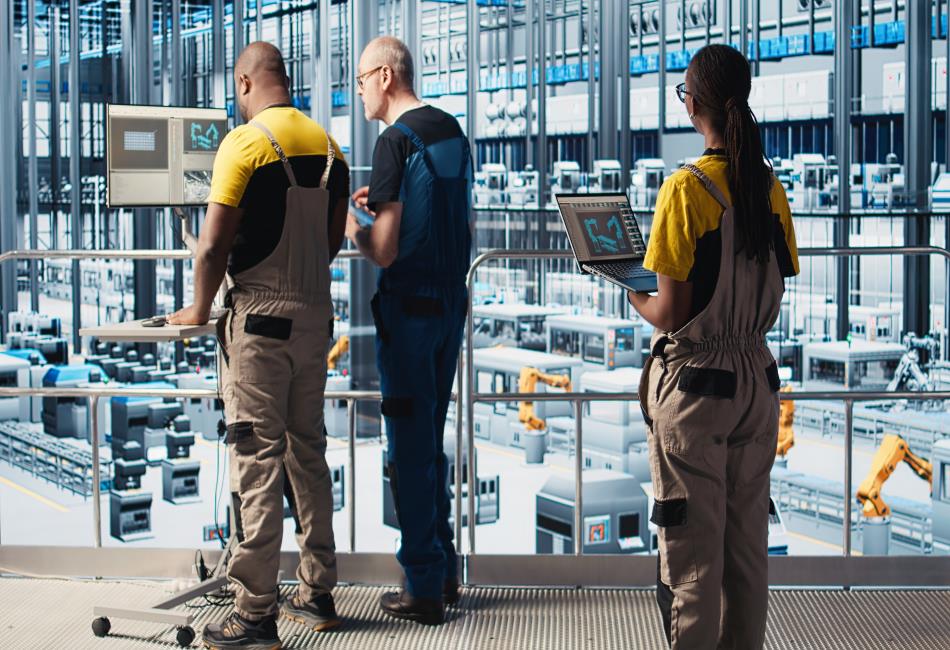Speed, precision, and adaptability are now more important than ever in today’s fast-paced manufacturing world. That said, a tremendous focus is placed on production technologies and automation, but one basic aspect that is overlooked is material handling.
However, it’s the backbone of every well-operated factory.
Whether in the movement of raw materials or the delivery of finished products, the material handling solutions determine the rhythm, safety, and profitability of the whole operation.
On that note, with the progress of the industry, this fundamental function has undergone an incredible transformation.
Material handling is no longer bound to forklifts or conveyor belts; it incorporates robotics, IoT-enabled tracking, and more to introduce intelligence and agility to manufacturing.
Below are some modern solutions that change the face of manufacturing today.
1. Autonomous Mobile Robots (AMRs)
Autonomous Mobile Robots (AMRs) are one of the most reliable material handling solutions in evolving modern manufacturing.
These intelligent self-navigating robots transport materials across facilities with incredible precision and adaptability, without restricted movements and expensive infrastructure.
Unlike traditional systems, AMRs have sensors, AI, and real-time mapping to detect obstacles, reroute immediately, and operate safely alongside human staff. It makes them perfect if your factory has dynamic workflows or requires frequent changes in its layout.
Plus, not only do AMRs reduce labor costs and human error, but they also operate 24 hours a day, substantially increasing productivity.
Its scalable deployment models and Robotics-as-a-Service (RaaS) packages can even help businesses scale their fleet on demand with minimal upfront cost.
Thus, as factories seek more agile, responsive operations, AMRs boast one of the most beneficial material handling solutions for any industry.
2. Automated Storage and Retrieval Systems (AS/RS)
Automated Storage and Retrieval Systems (AS/RS) are an excellent solution for manufacturers who want to increase their efficiency and minimize inventory mistakes.
These computer-controlled systems are programmed to store and retrieve materials from exact locations with minimum human effort.
In this context, by utilizing vertical space, AS/AR greatly enhances the storage capacity. That means the factories can stock more without increasing the size of their coverage. Automation also quickens order picking and replenishment, which lowers the number of laborers and provides a decreased risk of injury through manual handling.
Moreover, AS/RS improves accuracy by almost eliminating picking errors and providing reproducible processes.
These solutions even integrate with enterprise resource planning (ERP) and warehouse management systems (WMS). As a result, you can receive real-time inventory level information to make production scheduling and inventory control smarter.
All in all, AS/RS enables a manufacturer to have better control over its stock, increase space utilization, and increase throughput. It is extremely important in a competitive and dynamic industrial environment.
3. Conveyor and Sortation Systems

Modern conveyor and sortation systems have developed as sophisticated, high-speed material handling solutions needed for high-throughput manufacturing environments.
Compared to conventional belt conveyors, modern systems employ smart sensors, software algorithms, and modular designs to route products based on weights, dimensions, or location. This smart automation eases manual handling, increasing and ensuring uniformity in production.
These features are crucial in industries such as automotive, electronics, and consumer goods production, where precision is non-negotiable.
Advanced sortation capabilities also help reduce bottlenecks and optimize workflows, enabling scaling of operations without compromising quality or speed.
Further, most modern conveyor systems are effortlessly combined with robotics to produce the complete automated process for sorting, packaging, labeling, palletizing, etc. These techniques will go a long way in reducing manual handling while ensuring that the transport of goods is expedited, safe, and efficient.
Therefore, they stand out as dependable and future-proof material handling solutions.
4. IoT and Smart Sensors
The integration of Internet of Things (IoT) technology and smart sensors is transforming the material handling landscape by offering real-time, data-driven manufacturing insights.
These sensors are installed in machinery, storage units, and vehicles, for they constantly gather and transmit information about the machinery’s location, movement, temperature, load weight, equipment wear, etc. This information is imported into centralized systems with performance tracking capabilities, anomaly-detection features, and an ability to generate alarms prior to problems becoming expensive disruptions.
For example, a sensor can detect abnormal vibrations in a conveyor motor, which enables your maintenance team to respond before a breakdown happens. Smart sensors can also monitor the specific location of materials across the facility, minimizing delays and enhancing traceability. This extent of visibility enables better decision making, safety, and more effective allocation of resources.
5. Ergonomic and Safety Innovations

Incorporation of ergonomic and safety innovations continues to rise with the increased focus on worker well-being. Thus, it has become an essential part of modern solutions in material handling.
Consequently, manufacturing facilities are embracing human-centric technologies such as lift-assist devices, height-adjustable workstations, and wearable exoskeletons to alleviate the physical impact on employees.
Such tools allow the reduction of musculoskeletal strain. So, your workers can lift heavier loads and do repetitive work without tiredness. In turn, it creates a healthier, more productive workforce with reduced injury-related downtime and compensation costs. Along with these ergonomic measures, automated safety systems also improve operational safety.
For example, features like light curtains, machine guarding and proximity sensors ensure that accidents are handled by stopping machines.
Bottomline
Material handling is no longer a background operation—it’s a central player in a factory’s success.
Ultimately, by adopting advanced solutions like robotics, automation, IoT, conveyor sortation, and ergonomic designs, you can build smarter, safer, and more scalable production environments.
